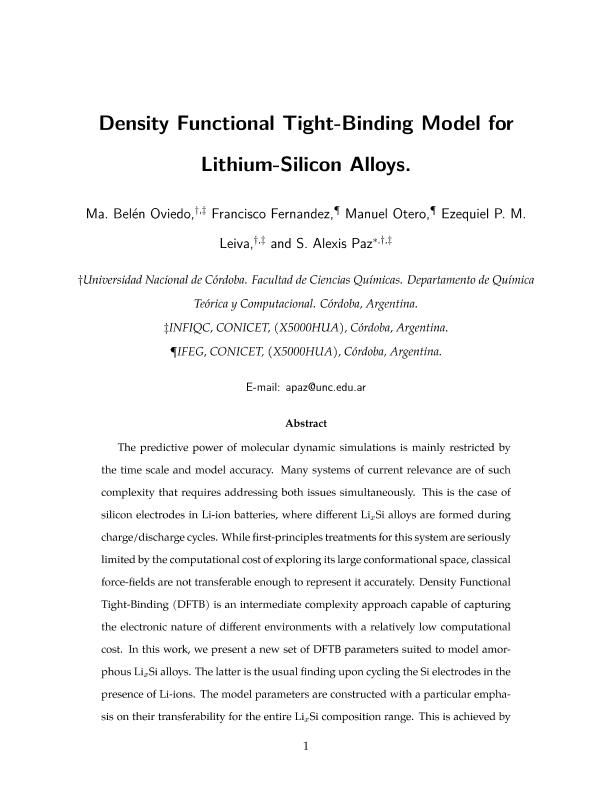Artículo
Density Functional Tight-Binding Model for Lithium-Silicon Alloys
Oviedo, María Belén ; Fernandez, Francisco
; Fernandez, Francisco ; Otero, Manuel
; Otero, Manuel ; Leiva, Ezequiel Pedro M.
; Leiva, Ezequiel Pedro M. ; Paz, Sergio Alexis
; Paz, Sergio Alexis
 ; Fernandez, Francisco
; Fernandez, Francisco ; Otero, Manuel
; Otero, Manuel ; Leiva, Ezequiel Pedro M.
; Leiva, Ezequiel Pedro M. ; Paz, Sergio Alexis
; Paz, Sergio Alexis
Fecha de publicación:
03/2023
Editorial:
American Chemical Society
Revista:
Journal of Physical Chemistry A
ISSN:
1089-5639
Idioma:
Inglés
Tipo de recurso:
Artículo publicado
Clasificación temática:
Resumen
The predictive power of molecular dynamic simulations is mainly restricted by the time scale and model accuracy. Many systems of current relevance are of such complexity that they require addressing both issues simultaneously. This is the case of silicon electrodes in Li-ion batteries, where different LixSi alloys are formed during charge/discharge cycles. While first-principles treatments for this system are seriously limited by the computational cost of exploring its large conformational space, classical force fields are not transferable enough to represent it accurately. Density Functional Tight Binding (DFTB) is an intermediate complexity approach capable of capturing the electronic nature of different environments with a relatively low computational cost. In this work, we present a new set of DFTB parameters suited to model amorphous LixSi alloys. LixSi is the usual finding upon cycling the Si electrodes in the presence of Li ions. The model parameters are constructed with a particular emphasis on their transferability for the entire LixSi composition range. This is achieved by introducing a new optimization procedure that weights stoichiometries differently to improve the prediction of their formation energies. The resulting model is shown to be robust for predicting crystal and amorphous structures for the different compositions, giving excellent agreement with DFT calculations and outperforming state-of-the-art ReaxFF potentials.
Palabras clave:
DENSITY FUNCTIONAL TIGHT-BINDING
,
LITHIUM
,
SILICON
,
BATTERIES
Archivos asociados
Licencia
Identificadores
Colecciones
Articulos(IFEG)
Articulos de INST.DE FISICA ENRIQUE GAVIOLA
Articulos de INST.DE FISICA ENRIQUE GAVIOLA
Articulos(INFIQC)
Articulos de INST.DE INVESTIGACIONES EN FISICO- QUIMICA DE CORDOBA
Articulos de INST.DE INVESTIGACIONES EN FISICO- QUIMICA DE CORDOBA
Citación
Oviedo, María Belén; Fernandez, Francisco; Otero, Manuel; Leiva, Ezequiel Pedro M.; Paz, Sergio Alexis; Density Functional Tight-Binding Model for Lithium-Silicon Alloys; American Chemical Society; Journal of Physical Chemistry A; 127; 11; 3-2023; 2637-2645
Compartir
Altmétricas



